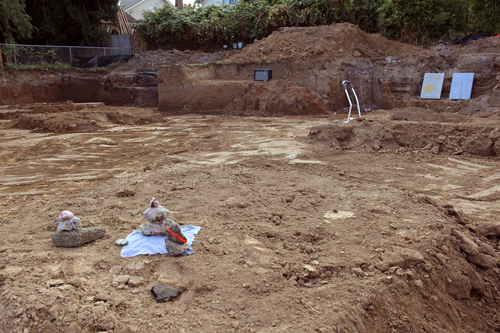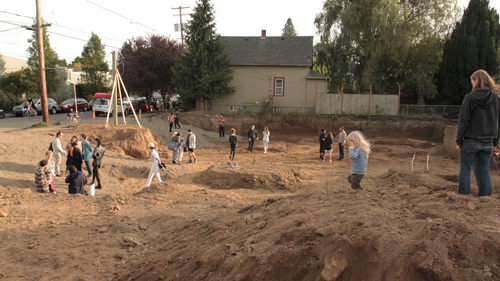Reflections by Taryn Tomasello
Minus Us was the third part of an ongoing exhibition series called Object Permanence Project* exploring physical presence, and disappearance curated and organized by the artist Taryn Tomasello.
Minus Us was set in an excavated lot on NE 14th Ave in between Beech St and Fremont St. in Portland, OR on October 13, 2014. The small houses previously occupying the lot had just been torn down, leaving a pit. The site had been prepped for new construction. This event took place in the very short interim between demolition and the pouring of new foundations. The moment was a crack we could squeeze into and pry open to make room for artists, subalterns, thinkers. By bringing an audience, the notions of private property and progress were challenged through a temporary re-commoning of the site. I wanted to dispute the stories of the havers, controllers, and owners. I invited people to explore the excavated building site as landscape as gallery -formally stunning, tragic.

Verb I, Verb II, Verb III by Anna Gray + Ryan Wilson Paulson, 2014 in foreground, Sidewalk in Blue, Sidewalk in Gray and Gold by Claire Redman, 2014, Action Moniker by Jonah Porter, 2014, and Ross Island by Jodie Cavalier, 2014 in background.
I had been noticing the cycle of demolition/rebuilding of the city around me as the Re-urbanization movement swept in, bringing its developers and investors. The new homes being built were bigger, more expensive and thus not within economic reach for the previous inhabitants. Being an artist in the United States usually means living below the poverty line, so the city was rapidly losing artists. More importantly, this neighborhood is a historic redline neighborhood, meaning that it had been an area designated by the financial institutions and the City of Portland for People of Color. Although If People of Color tried to buy a house outside of this zone, the banks would not lend them the money. This rush to develop and ‘improve’ this neighborhood was displacing countless layers of the city at once.

Ross Island, Jodie Cavalier, video loop on television monitor, 2014.
It wasn’t hard to find formally fascinating examples of such sites. It was very challenging, however, to time an event. On any weekday with good weather laborers would be working. If the demolition and weather worked against us, the foundation would be poured before the weekend. I wanted the absence, the mythical blank slate, the demolished cleansed ground. Finally, I found it right next door to a house my friends were renting, so we could run power with extension cords, on a Thursday before a long weekend: Minus Us would take place on a holiday commemorating a history I decry; Columbus Day-renamed and celebrated in Oregon as Indigenous Peoples’ Day.** I was struck by the irony of a site reminiscent of so many ruins of Pre-Columbian civilizations -prescient visions of our own societal decay.
We, as artists and audience, declared our agency through assembly. We stepped over the line, crossing from the sidewalks into the yard, into the footprint, into the backyard, pushing up against chain-link fences, gazing into the neighbors’ yards, bringing with us our children our fears, our friends, neighbors, our grocery baggers, and teachers. We repurposed the furniture of the developers, using them to declare our position. The audience temporarily occupied this land that hovered between private and public space for a brief moment.

Minus Us, 2014
The artworks provided a scaffolding and context. keyon gaskin’s activation of the space through performance, movement, and props – the focal point of the event – challenged our sense of safety. He pushed the boundaries of what we could get away with in this visible, soft occupation. While most of the artworks poked at the inevitable, keyon’s work challenged our compliance and safety. At one point, keyon climbed a chain link fence separating the site from the neighboring yard. The neighbors came out. I realized the very real risk keyon was taking, as a black man in a black hoody, trespassing, running in the pit, climbing a fence. The whole time I was asking myself, “How can I make sure to take full responsibility for this performance if the cops come?” I was aware that although this event was a collective risk we took, some bodies would be targeted more than others.

keyon gaskin performing Excerpts from “it’s not a thing” as an activation of the space, 2014
Luckily, no one tried to shut us down. Kids played in the dirt, we drank soda, and chatted. The social was an important medium and it was fully activated. By sundown, we left as if nothing had happened.
I identified, in this brief proprietary lapse, a moment where we might place ourselves. The only thing of any monetary value was the land itself, the exposed dirt, the hole where we might once have lived, our place. Shortly after the event new houses were built on the site. The inaccessibility of these houses, once built, is a common refrain. Yet, we had accessed the hole, as empty space, for a limited time. As soon as the concrete was poured, something happened. We were no longer welcome. I challenge all of us to find the bits of the everyday that strengthen us in reestablishing the commons in moments of lapse.
Minus Us extends a solidarity to all displaced people.

Image of Minus Us site, 2017. As if it never happened.
*Object Permanence Project is curatorial practice as art, exploring the relocation of the physicality of art. Object permanence is an early childhood developmental milestone, the understanding that objects continue to exist even when they cannot be observed (seen, heard, touched, smelled or sensed in any way). This series is an anti-nationalist anti-Globalist endeavor. It was born out of a desire to point out that the way artists have become more and more dependent on virtual webs to distribute their ideas, the relevance of physical representation is more emphatic. Removing the commodity from art while addressing the physicality of materiality this series transports and organizes art experiences.
**Minus Us was critiqued for hosting the event on Columbus Day referencing colonialism and Indigenous Peoples without specifically engaging with Indigenous Artists and Tribes from the Pacific Northwest. This is a fair critique and must be noted. It was a reminder to all of the importance of time, timing, and context. Also, the histories of displacement and oppression compound the further back we go. I will be forever asking myself: Whose voice I can amplify and why? Which history do I choose to represent?
Artists and Works Included
keyon gaskin
Performance at 4pm
Excerpts from “it’s not a thing”
Anna Gray + Ryan Wilson Paulson
Verb I, Verb II, Verb III
rubble, fabric, thread
Jodie Cavalier
Ross Island
video loop on television
Claire Redman
Sidewalk in Blue, Sidewalk in Gray and Gold
Cement and pigment on canvas
Jonah Porter
Action Moniker
pvc pipe, foam insulation, plaster, zip ties, jump rope
…with Spreading Rumors and Roger Peet
Taryn Tomasello is an artist, writer, curator, and organizer. Her practice is centered on memory, risk and difference inside human geography. The work takes place between video, performance, text and relational sculpture, exhibiting a dense, variable texture, stoic resemblances and mythic attributes, and a deep sympathy for the uninvited. She currently lives in Portland, Oregon with her family. Her videos have been screened by Experimental Half Hour, Free Spirit News and other experimental video platforms. She has performed solo music and collaboratively under the monikers Aures and Wail Signs.
Tomasello’s curatorial endeavor, Object Permanence Project, is an itinerant artists’ gallery that takes shape through exhibitions and events at different host venues often non-traditional sites. It has exhibited at Cibali Arthouse, Istanbul Turkey and ŠKVER, Mali Lošinj Croatia with an upcoming exhibition in Athens, Greece. She is part of CENTRAL, an independent creative research initiative focused on an expanded concept of the built environment. Currently she is a research associate with the Oregon Institute of Creative Research focusing on the aesthetics of erasure in architecture, demolition, and ethics of planning.